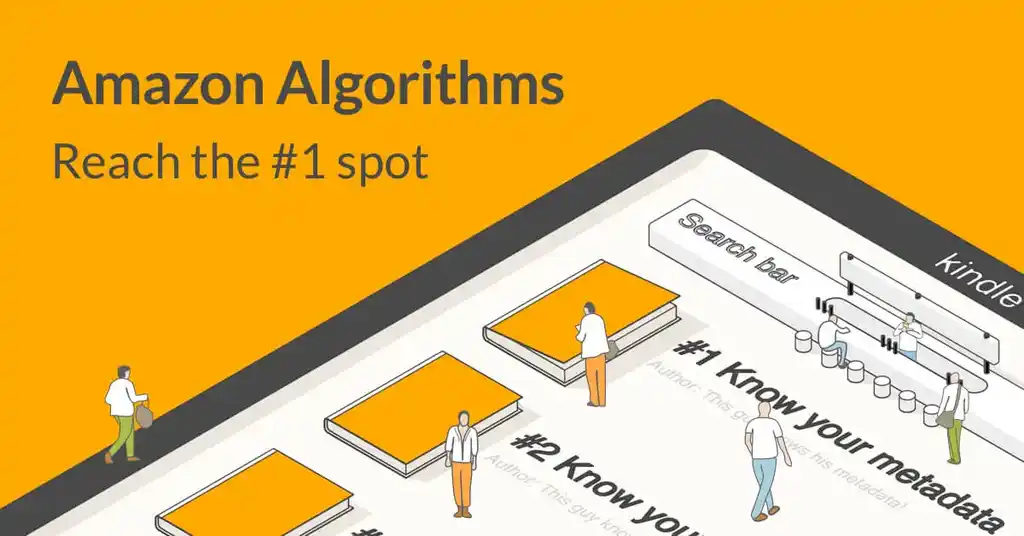Guides • Understanding Publishing
Last updated on Jul 19, 2023
Amazon Algorithms for Authors — Demystified!
Ricardo Fayet
Reedsy co-founder and Chief Marketing Officer, Ricardo Fayet has worked with hundreds of authors on their launches and marketing campaigns. He is the author of two bestselling guides on marketing for authors, and a regular presenter at the largest writers' conferences.
View profile →Selling your book through Amazon is one of the simplest ways to get it out into the world. But far from being a cozy bookstore with a reading nook and a smiley owner, Amazon is a hulking machine of a retailer, governed by complex sets of rules and calculations — in a word, algorithms — used to order the ever-growing number of products on its store.
You’ll notice our use of the plural when referring to Amazon algorithms. It’s a common misconception that there is only one almighty algorithm. But this isn’t the case — and promises of the secrets to a singular Amazon algorithm is one way to spot phony marketing advice from a mile away. The complexity and size of the Amazon store demand several interconnected algorithms to index and rank products across their site. For example, Amazon’s search algorithm is completely different from their Best Seller list algorithm, which is also different from the algorithm powering their book-recommendation emails.
Though daunting to many, these algorithms don’t have to be intimidating once you know what they want and how they work.
At Reedsy, we’ve helped tens of thousands of authors learn to successfully publish their book. In this post, we’ll demystify Amazon’s algorithms and reveal ways of leveraging their inner workings to promote your book in the best possible way.
If you want even more tricks of the trade, I released a book that includes helpful chapters on tackling Amazon’s algorithms. Download How to Market a Book for free here!
The fundamental factors of Amazon’s algorithms
Before we can get to taming the beast, it’s important to know what it wants. In this case, the Amazon animal is driven by its desire to maximize sales. In other words, the main purpose of the algorithms is to show customers the products (in this case, books) which they think they are the most likely to buy.
To achieve this, Amazon algorithms will rely on two types of factors:
- Factors related to sales performance;
- Factors related to “product-market fit.”
Sales performance factors will decide whether Amazon will want to recommend your book in the first place (after all, there’s no point in recommending a book if it’s not selling), whereas “market fit” factors will decide whom Amazon will want to recommend your book to. Both are equally important, so let’s look at some examples.
Sales performance factors
Historical sales patterns
The algorithms give preference to titles that maintain strong, steady sales rather than inconsistent spikes. If your daily sales jump from five copies to one hundred copies in a single day, followed by a drop back down to five, Amazon assumes that the spike was an anomaly and disregards it. So aim for a daily sales count that you can maintain over many days.
The way you schedule your book marketing efforts will impact how and when your sales come in. To avoid large spikes which quickly drop off, spread your promotion across different platforms and audiences over a few days. For instance, when you first release your book, you might not want to inform your entire mailing list about it on the same day. Instead, stagger emails out to segments over a couple of days.
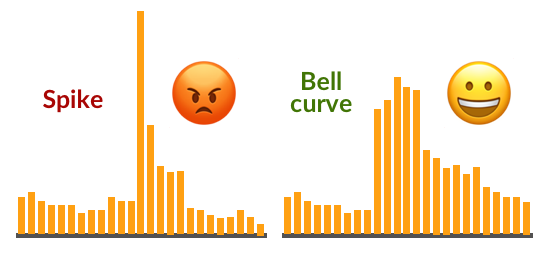
On-page conversion
Amazon doesn’t just care about how many sales you’re getting but also how many sales you’re getting in proportion to the number of visits your book page is getting. This ratio is your sales conversion. If a large portion of the users who visit your page end up buying your book, then your conversion is good — and the Amazon algorithms look favorably on this. Two books could have the same number of daily sales, e.g., 1,000 sales, but if one book page has been visited 2,000 times that day and the other has been visited 10,000 times, Amazon will favor the former.
Good conversion starts with producing a great book and knowing how to market it on retailer sites. To optimize your Amazon page for sales, here are the things you should focus on:
- A good cover. Catch a customer’s eye with a dazzling professional cover that makes them want to click on your book.
- An irresistible blurb. Entice your readers to know more and get them over the hurdle to click the BUY NOW button.
- Multiple positive reviews. Good reviews prove that your book is worth reading and instill trust in your customers. When was the last time you bought a product with no reviews?
Market fit factors
The algorithms are incredibly sophisticated and, over time, will know with deadly accuracy who to sell your book to — but they need a little push to get started and understand what your book is. That’s what keywords, categories, and on-page metadata are for.
Keywords
When readers type anything into Amazon’s search bar (“dinosaur adventure,” for example), the result will be a list of titles associated with that search — which should hopefully be rollicking books set in the Jurassic period.
When uploading your book through KDP, Amazon gives you the option to list seven keywords phrases (of up to 50 characters). By choosing your keywords wisely, you can reach readers who run a search using those specific words and any associated phrases (the algorithms are smart that way).
Pro-tip: Get a read on your audience early by downloading this author market research checklist.

FREE RESOURCE
Market Research Checklist
Find your ultimate target audience with our checklist.
To learn how to optimize your book for search, check out our post on selecting Amazon keywords.
Categories
To make the vast selection of books housed by Amazon a little easier to navigate, Amazon divides up books based on category and genre, much like a traditional brick-and-mortar bookstore would. Amazon categories are nested in terms of size and specificity, starting with the deepest level subcategories and going up to larger parent categories. For instance, Romantic Suspense is a subcategory of Mystery, Thriller and Suspense.
When you publish a book on Kindle Direct Publishing, you can list your book in up to three categories. As with keywords, your category choices are crucial: if you place your book in a subcategory that doesn’t match your book’s content, you will struggle to win over people browsing in that category. And if that happens, your ranking within that category will flounder, and you will have wasted an opportunity.
For tips on how to “shelve” your book in the rights part of the Kindle store, check out our post on choosing Amazon book categories!
On-page metadata
The information on your book page is an opportunity for you to entice customers and let Amazon know about your book’s content so it can better identify your target audience.
Titles
Coming up with a suitable title for your book means choosing something that piques a reader’s interest while also giving the algorithms a nudge in your favor. That’s why authors self-publishing on Amazon often sneak keywords in their titles, subtitles, and series titles where applicable. Titles that feature close or exact matches for search terms are guaranteed to be indexed for them. However, proceed with caution: don’t stuff your title with so many keywords that it reads as unnatural or spammy.
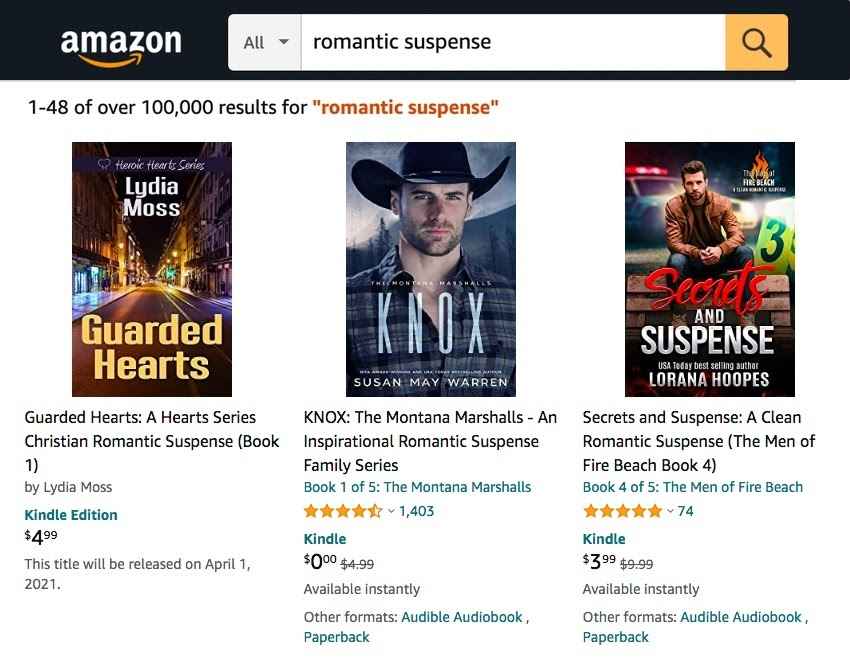
Book description
Unlike the keywords you manually select or feature in your title, the ones that appear in Amazon book descriptions won’t necessarily be rewarded on a one-for-one match basis. This doesn’t mean that they’re completely ignored, though, and there is still a chance that a book will index for keywords found in its book description, but resist the urge to keyword stuff here as well.
As much as you want your page to be optimized for algorithms, you need your book description to be enticing for human customers to convert, and a book description crammed full of ill-placed keywords just isn’t that. Write for people, not robots!
Customers who bought this also bought…
While keywords, categories, and on-page metadata are vital for Amazon to get to know your book, it’s your “also boughts” that will really inform the algorithms of where your book fits in the market.
See, Amazon keeps track of all the books that customers buy. This allows them to establish a map of connections between books which Amazon takes to be similar on the basis that they were bought by the same people — hence the term ‘also bought.’
This is then used to identify the other books that another customer who bought that book might want to buy next. In the case of Catch-22, for example, Amazon might see that buyers of that book have also bought Slaughterhouse-Five and The Catcher in the Rye.

There was a time when also boughts could be found on all book pages, just underneath the description, but this isn’t always the case anymore. The fact that also boughts aren’t always visible to users on product pages doesn’t mean they’re not there, at least for Amazon’s purposes. Though sometimes invisible, also boughts still hugely factor into the inner workings of Amazon’s recommendations.
Six examples of algorithms in action
Now that we understand the factors that guide Amazon’s algorithms as a whole, let’s take a look at Amazon’s main visibility spots — areas where readers can find new books to read — and the individual algorithms that manage each of them. Understanding what each of these algorithms is looking at will help you optimize your book visibility in each of these areas.
Best Sellers lists
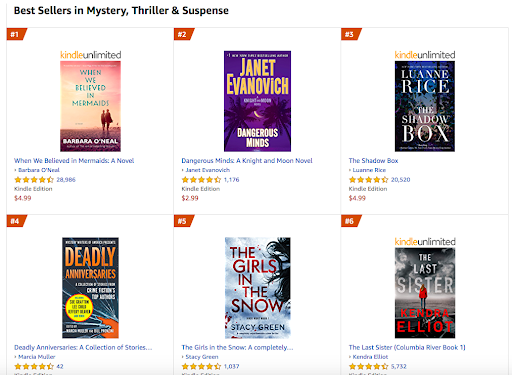
The Best Seller list algorithm is responsible for the various Amazon Best Seller lists (the clue’s in the name, right?). There is an overall Best Sellers list for the whole of the Amazon store and an individual one for every single genre and category. Each list, updated hourly, shows the top 100 books for that category ordered by sales rank.
Wondering what genre to place yourself in? Read up on genres here.
📊 What data is the algorithm looking at?
The Best Sellers list algorithm looks exclusively at paid sales and Kindle Unlimited borrows to determine the ranking of books. Free book sales are not taken into consideration.
🚀 How can you boost your book?
Big book sales will ultimately come down to stellar marketing. One tactic that is particularly useful here is a discounted price promotion (not a free giveaway), which will give you that bump in sales that you’re after. Enrolling in KDP Select (more here) will give you access to those all-important Kindle Unlimited readers whose borrows will also help push you further up the list.
Check out our course on running a price promotion to boost your way up the Best Sellers list.
Hot New Releases
These lists are essentially the Best Sellers list, but for the most recent books from each category.
📊 What data does the algorithm look at?
As a subset of the Best Sellers list, this book is based on the same factors: paid sales and Kindle Unlimited borrows for books on preorder OR released in the past 30 days.
🚀 How can you boost your book?
The trick here is to have started your marketing efforts well before releasing your book, creating enough of a buzz and building an author platform so that you’ll have sales right from your release date to push you up this list. By making your book available for preorder, you will even have the chance of being on this list before your official release date.
Popularity lists
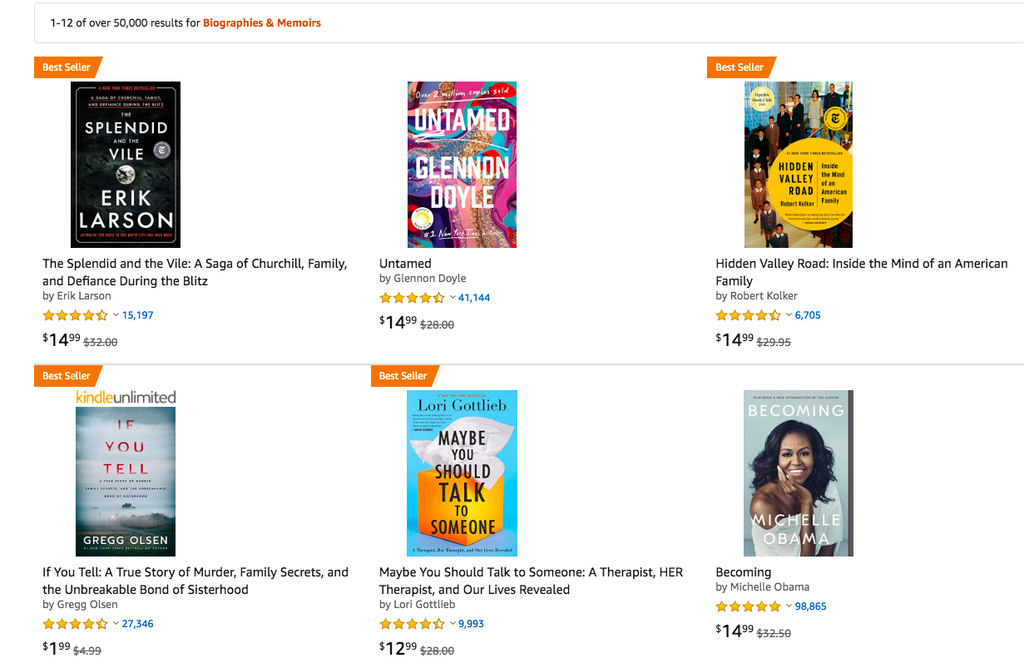
This elusive list displays books that are featured in any particular category. The popularity list is particularly powerful not for its on-page organization (it’s actually quite hard for readers to find), but for the way that it influences other visibility spots like email recommendations and search results.
📊 What data does the algorithm look at?
Unlike the Best Sellers list, the Popularity list algorithm does not take into consideration Kindle Unlimited borrows. It does, however, look at both paid and free sales. With that being said, it awards sales at different prices differently, across the spectrum. So while a $0 purchase will still count for something, it will move the needle much less than, say, a $2.99 sale, which in turn, will count a lot less than a $9.99 sale.
🚀 How can you boost your book?
Free sales are where you have the most potential to manipulate your position on the Popularity list. While free sales count for less relative to paid sales, this is a quantity over quality situation where the sheer number of sales you can get through a free giveaway could significantly boost your ranking.
Pro tip: The Popularity list is updated less regularly than the Best Sellers lists, so don’t be alarmed if the effects of your free giveaway take a few days to show up.
Search results
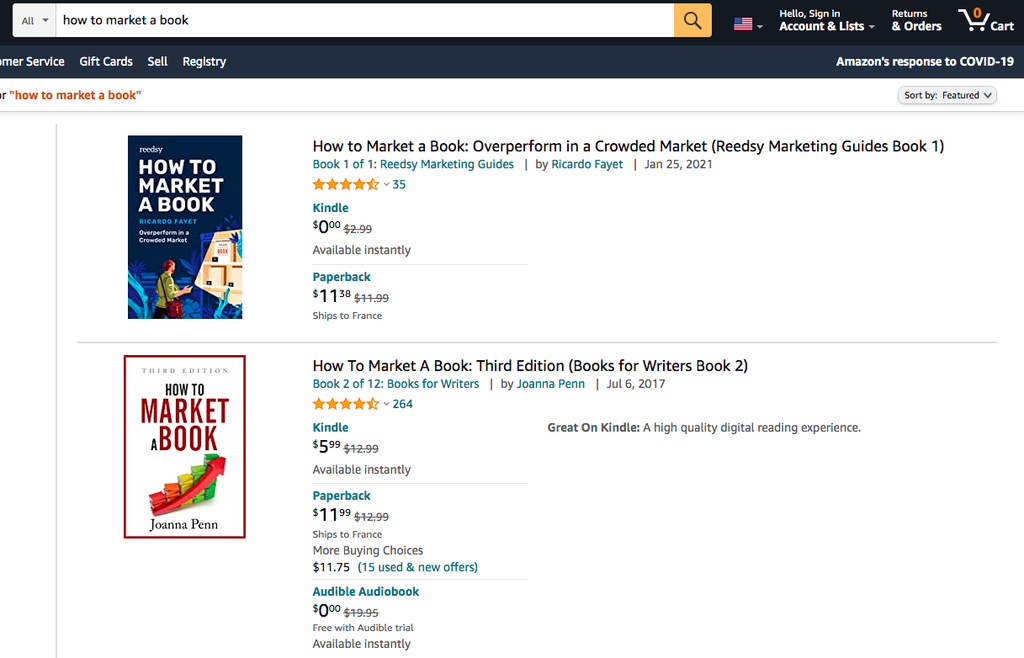
Amazon also functions as a search engine, much like Google. So when a reader comes to the site looking for a new book to read, Amazon delivers them a list of results that match their search query.
📊 What data does the algorithm look at?
The algorithm will attempt to match books with search terms and then rank them by relevance to deliver best-match results. However, before worrying about ranking, the algorithm has to index books for a term first.
To index your book for a particular search term, the primary factors the search algorithm looks at are your book’s metadata and chosen keywords. Your book is guaranteed to index for a term if there is an exact or close match for it in your keywords or title — and as we’ve mentioned previously, the book description and reviews may also help your book appear for specific search terms, although not as reliably as with keywords or titles.
From there, metadata and keywords are used again in determining search rank, where an exact or closeness of match to the search term — perceived as relevance — will strongly boost ranking.
Position on the Popularity list also plays a vital role in determining search results rankings. Higher ranking on the Popularity list will favorably influence search rankings. The search algorithm also keeps an eye on a book’s sales and conversion performance on previous searches for a particular term or terms like it to factor this into search ranking.
🚀 What can you do to boost your book?
By thinking carefully about what your target audience will type into Amazon to find a book like yours, you can optimize your keywords and metadata for these searches. Making the most of a free giveaway to climb your way up the Popularity list will also give your book a boost in the search results.
Highly Rated lists
Highly rated lists do exactly what they say on the tin: they show the highest rated books for each category.
📊 What data does the algorithm look at?
The Highly Rated list is determined entirely based on reviews. The algorithm looks at both the number of reviews you have and the level of praise those reviewers have given. You might get bonus points for reviews that are verified or marked as ‘helpful’ by other users.
🚀 What can you do to boost your book?
There’s no real magic trick to turning up in these lists — just the winning formula of an incredible book and an active and dedicated street team who are ready to leave an honest review when the time comes.
Check this article out to learn more about how to build a street team for your book launch.
Email recommendations
Amazon recommendation email
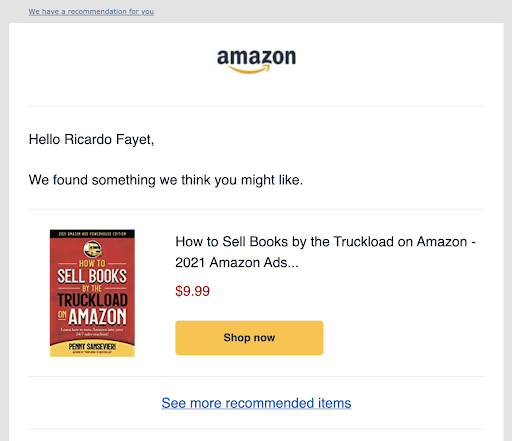
Amazon’s recommendation emails make up the highly personalized side of their sophisticated recommendation system. Emails are sent out to individual customers to suggest a book they might like to buy that has been selected specifically for them.
📊 What data do the algorithms look at?
Amazon recommendations work on the assumption that people who bought one book will like another book of a very similar flavor and that books selling well will continue to sell well.
To identify similar books, the email recommendation algorithm relies on the mapping between books formed by those ‘also boughts’ we discussed earlier. If Amazon sees that a customer has bought a book that appears in the ‘also boughts’ for your book, there’s a good chance it will recommend your book to that customer.
The recommendation emails algorithm also considers sales performance, which can indicate whether a book is ‘hot’ or not. Good sales and conversion show the algorithm that if they recommend your book to someone, there’s a good chance they will want to buy it.
🚀 What can you do to boost your book?
The key thing here is to keep your ‘also boughts’ clean. Keep your marketing efforts focused on your genre only. For example: only take part in newsletter swaps or author cross-promotion only with authors from the same genre. The promotion of your romantic suspense novel by a friendly sci-fi author might send a ton of sci-fi readers to your book, which, while exciting, could mess with your ‘also boughts.’
To consolidate your knowledge on Amazon Algorithms, don't forget to sign up to this course:

FREE COURSE
Amazon Algorithms for Authors
Learn to optimize your book description, pick categories, and sell more books.
Appeasing Amazon’s algorithms might seem like a crazy juggling act. Still, once you wrap your head around the basics and learn to take the bitesize opportunities for optimization that are actually within your control, you should hopefully see positive results. Get it right, and Amazon will start promoting your book for you — and once that happens, you’re on the road to reaching your full potential as a self-published author!


